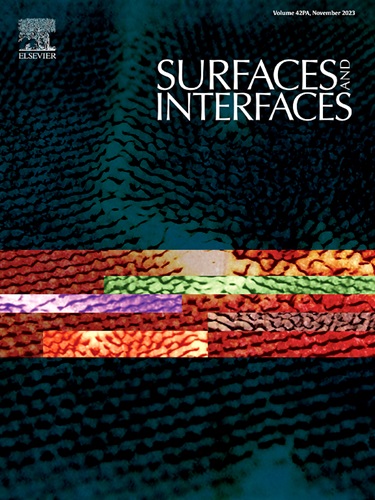Nickel-sensitized Sb: SnO2 thin films for enhanced room temperature hydrogen gas sensing
IF 5.7
2区 材料科学
Q2 CHEMISTRY, PHYSICAL
引用次数: 0
Abstract
This study presents the development of hydrogen gas sensors operating at room temperature, utilizing DC-sputtered nickel (Ni) catalysts patterned in an island-like morphology on RF-sputtered antimony-doped tin oxide (Sb: SnO₂) thin films. The Ni deposition was systematically varied by adjusting deposition times from 0 to 20 min in 5-minute increments, with characterization via SEM-EDS confirming the Presence of Ni and other deposited elements. XRD analysis showed a progressive enhancement in the Ni peak intensity at 2θ = 44.83° as deposition time increased. The patterned Ni significantly altered the surface roughness of the Sb: SnO₂ films, leading to notable changes in wettability, including increased hydrophobicity at 15 min of deposition. However, at 20 min, excessive Ni coverage hindered gas adsorption, reducing sensor performance. The activation energy for hydrogen detection decreased significantly, from 3.12 eV for Sb: SnO₂ films to 1.19 eV with Sb: SnO2-Ni (15 min), as determined using the Arrhenius equation. Sensors with 15 min of Ni deposition demonstrated optimal performance, detecting 0.5 ppm hydrogen at 25 °C, with a response of 3.36 % and rapid response/recovery times of 6/9 s. These enhancements are attributed to Fermi energy alignment and the spillover mechanism. The Sb: SnO2-Ni (15 min) sensor exhibited excellent stability over 42 days, good repeatability, and linearity. Humidity tests showed the response decreased from 40 % to 8 % for 10 ppm hydrogen as relative humidity increased from 35 % to 85 %. This study highlights a novel Ni patterning on the Sb: SnO2 film approach for enhanced hydrogen sensing performance at room temperature.

求助全文
约1分钟内获得全文
求助全文
来源期刊

Surfaces and Interfaces
Chemistry-General Chemistry
CiteScore
8.50
自引率
6.50%
发文量
753
审稿时长
35 days
期刊介绍:
The aim of the journal is to provide a respectful outlet for ''sound science'' papers in all research areas on surfaces and interfaces. We define sound science papers as papers that describe new and well-executed research, but that do not necessarily provide brand new insights or are merely a description of research results.
Surfaces and Interfaces publishes research papers in all fields of surface science which may not always find the right home on first submission to our Elsevier sister journals (Applied Surface, Surface and Coatings Technology, Thin Solid Films)
 求助内容:
求助内容: 应助结果提醒方式:
应助结果提醒方式:


